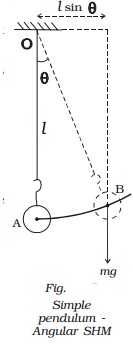Chapter: 11th 12th std standard Class Physics sciense Higher secondary school College Notes
Oscillations of a simple pendulum

Oscillations of a simple pendulum
A simple pendulum consists of massless and
inelastic thread whose one end is fixed to a rigid support and a small bob of
mass m is suspended from the other end of the thread. Let l be the length of
the pendulum. When the bob is slightly displaced and released, it oscillates
about its equilibrium position. Fig. shows the displaced position of the
pendulum.

Suppose the
thread makes an angle θ with the vertical. The distance of the bob from the
equilibrium position A is AB. At B, the weight mg acts vertically downwards.
This force is resolved into two components.
(i)
The
component mg cos θ is balanced by the tension in the thread acting along the
length towards the fixed point O.
(ii)
mg
sin θ which is unbalanced, acts perpendicular to the length of thread. This
force tends to restore the bob to the mean position. If the amplitude of
oscillation is small, then the path of the bob is a straight line
∴
F = −mg sin θ ...(1)
If the angular
displacement is small sin θ ≈ θ
∴
F = −mg θ ???.(2)
But θ = x/l
∴
F = − mg (x/l)
Comparing this
equation with Newton?s second law, F = ma we get, acceleration a = -gx/l ?(3)
(negative sign
indicates that the direction of acceleration is opposite to the displacement)
Hence the motion of simple pendulum is SHM.
We know that a =
−ω2x
Comparing this
with (3)
ω2 =
g/l or ω =rt(g/l) ----(4)
Time period T =
2 π/ ω
T = 2 π rt(l/g)
∴
frequency n = 1/2 πrt(g/l) ?..(6)
Laws of pendulum
From the
expression for the time period of oscilations of a pendulum the following laws
are enunciated.
(
i) The law of length
The period of a
simple pendulum varies directly as the square root of the length of the
pendulum. (i.e) T α l
(ii)The law of acceleration
The period of a
simple pendulum varies inversely as the square root of the acceleration due to
gravity.
(i.e) T α 1 g
(iii) The law of mass
The time period of a simple pendulum is
independent of the mass and material of the bob.
(iv)The law of
amplitude
The period of a
simple pendulum is independent of the amplitude provided the amplitude is
small.
Note : The
length of a seconds pendulum is 0.99 m whose period is two seconds.
2 = 2π.rt(l/g)
l= 9.81x 4 / 4 π2=0.99 m
Oscillations of simple
pendulum can also be regarded as a case of angular SHM.
Let θ be the
angular displacement of the bob B at an instant of time. The bob makes rotation
about the horizontal line which is perpendicular to the plane of motion as
shown in Fig..
Restoring torque
about O is τ = − mg l sin θ
τ = −m g l θ [ ∵
θ is sm all] ...(1)

Moment of
inertia about the axis = m l 2 ...(2)
If the amplitude
is small, motion of the bob is angular simple harmonic. Therefore angular
acceleration of the system about the axis of rotation is
α = r/l = -mgl θ
/ ml2
α = - (g/l)
θ ?.(3)
We know that α =
−ω 2 θ ??.(4)
Comparing (3)
and (4)
−ω 2θ
= -(g/l) θ
angular
frequency ω = rt(g/l)
Time period T =
= 2π / ω = 2π .rt(l/g)
Frequency n = 1
/ 2 π . rt(g/l)
Related Topics